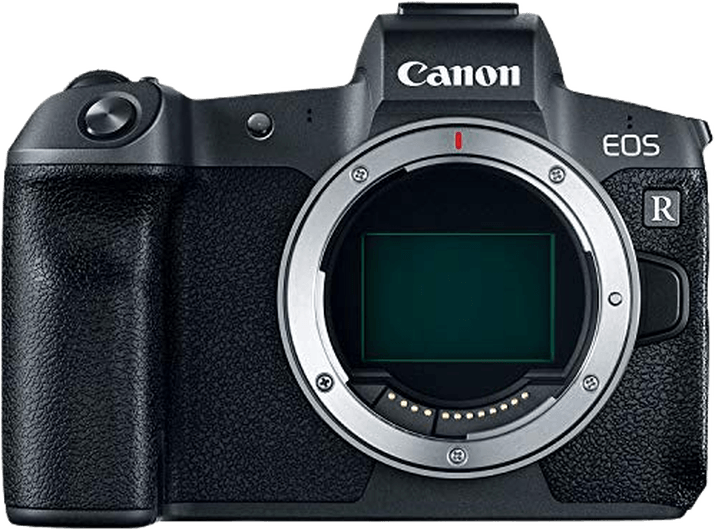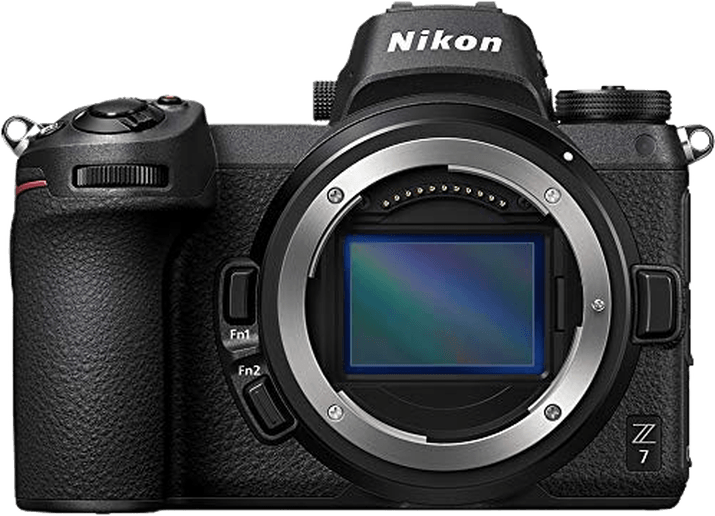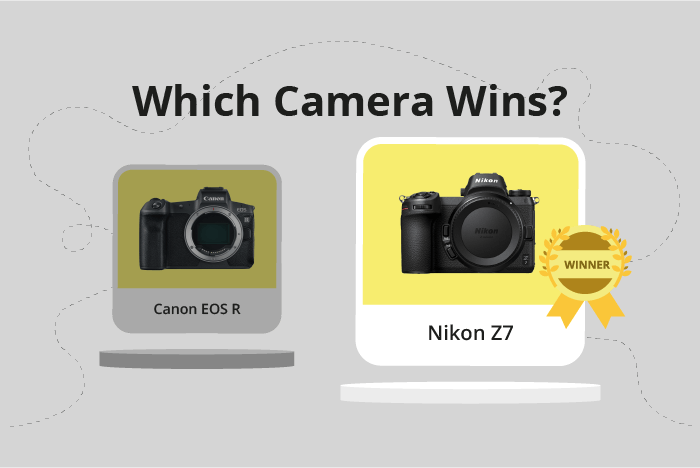Canon EOS R vs Nikon Z7 Comparison
Canon EOS R

Nikon Z7

The Nikon Z7 comes out on top with a score of 82/100, while the Canon EOS R trails behind with a score of 74/100. Both cameras share similarities as mirrorless cameras released in 2018. They also have comparable dimensions, with the Canon EOS R measuring 136 x 98 x 84mm and the Nikon Z7 at 134 x 101 x 68mm.
The Nikon Z7 surpasses the Canon EOS R with its higher score, reflecting its superior performance and features. Despite its higher launch price of $3400 compared to the Canon EOS R’s $2300, the Nikon Z7 justifies its cost with better overall performance.
The Canon EOS R, however, does have an advantage in terms of weight, being lighter at 485g compared to the Nikon Z7’s 675g. This can make it more convenient for photographers on the go.
Taking these factors into account, the Nikon Z7 proves to be the better camera, but the Canon EOS R offers a more budget-friendly and lightweight option for those who prioritize portability.
Canon EOS R vs Nikon Z7 Overview and Optics
The Nikon Z7 surpasses the Canon EOS R in optics with a score of 86/100, compared to the Canon’s 73/100. Although both cameras share similarities, the Nikon Z7 outperforms the Canon EOS R in various aspects.
Both cameras feature a full-frame CMOS sensor, with the Canon EOS R having 30.3 megapixels and the Nikon Z7 boasting 45.7 megapixels. Their respective processors, the Digic 8 and Expeed 6, provide efficient image processing. Additionally, they both have their own lens mounts, with the Canon using the Canon RF and the Nikon using the Nikon Z.
The Nikon Z7’s higher score is due to its superior specifications. It has a faster shooting speed of 9, compared to the Canon EOS R’s 8, allowing for better continuous shooting. Furthermore, the Nikon Z7 has a higher DXOMARK sensor score of 99, while the Canon EOS R has a score of 89, indicating better overall image quality. The Nikon Z7 also benefits from built-in image stabilization, which is lacking in the Canon EOS R.
Despite its lower score, the Canon EOS R has some advantages. Its Canon RF lens mount provides access to a growing selection of high-quality lenses, while the Nikon Z mount is still expanding its range. However, this difference may not be significant for some users.
Taking these factors into account, the Nikon Z7 emerges as the superior camera in terms of optics. Its higher megapixel count, faster shooting speed, better DXOMARK sensor score, and built-in image stabilization contribute to its higher optics score. On the other hand, the Canon EOS R remains a competitive option with its Canon RF lens mount, but it falls short in comparison to the Nikon Z7’s performance.
Canon EOS R vs Nikon Z7 Video Performance
The Nikon Z7 emerges as the winner in the video capabilities comparison with a score of 83/100, while the Canon EOS R scores 70/100. Both cameras share some common specifications, such as having a maximum video resolution of 4K and dimensions of 3840 x 2160. Additionally, both cameras come with built-in time-lapse functionality.
However, the Nikon Z7 surpasses the Canon EOS R in terms of video performance. The Z7 offers a higher maximum video frame rate of 60fps, which is double the EOS R’s 30fps. This higher frame rate allows for smoother and more detailed video playback, making the Nikon Z7 a superior choice for videographers seeking professional-quality footage.
On the other hand, the Canon EOS R does not have any notable advantages over the Nikon Z7 in terms of video capabilities. With a lower video score and a significantly lower maximum video frame rate, the EOS R falls short in comparison to the Z7.
Based on the comparison, the Nikon Z7 clearly outperforms the Canon EOS R in video capabilities. The higher video score and superior maximum video frame rate make the Z7 a better choice for those focusing on videography. While both cameras have 4K resolution and time-lapse functionality, the Z7’s higher frame rate sets it apart as the superior option in this category.
Canon EOS R vs Nikon Z7 Features and Benefits
The Canon EOS R and Nikon Z7 tie in feature scores, both receiving an impressive 87 out of 100. These cameras share numerous specifications, making them strong contenders in the market. Both cameras have a 3.2-inch screen size, a screen resolution of 2,100,000 dots, a touchscreen, a flip screen, WiFi, and Bluetooth capabilities. Neither camera includes GPS functionality.
Despite the identical scores, the Canon EOS R has some advantages over the Nikon Z7. It is known for its user-friendly interface and intuitive controls, making it an excellent choice for photographers of all skill levels. The EOS R also boasts a slightly faster autofocus system, allowing users to capture fast-moving subjects with ease. Additionally, the Canon EOS R is compatible with a wider range of lenses, providing more versatility when it comes to shooting different subjects and scenes.
On the other hand, the Nikon Z7 excels in image quality and dynamic range. It has a higher megapixel count, resulting in sharper and more detailed images. The Z7 also features a better in-body image stabilization system, ensuring steadier shots and reducing the need for a tripod in certain situations. Furthermore, Nikon’s color science produces more accurate and pleasing colors in images compared to the Canon EOS R.
Both cameras have their strengths and weaknesses, and the choice between them ultimately depends on the photographer’s needs and preferences. The Canon EOS R is a well-rounded camera with a user-friendly interface, faster autofocus, and wider lens compatibility. In contrast, the Nikon Z7 shines in image quality, stabilization, and color accuracy. Each camera has its merits, and either would make a great addition to a photographer’s gear collection.
Canon EOS R vs Nikon Z7 Storage and Battery
The Canon EOS R and Nikon Z7 have identical storage and battery scores of 35/100. Both cameras have a single memory card slot, with the EOS R accepting SD/SDHC/SDXC (UHS-II compatible) cards and the Z7 using XQD cards. Additionally, both cameras offer USB charging capabilities.
The Canon EOS R outperforms the Nikon Z7 in battery life, providing 370 shots compared to the Z7’s 330 shots. The EOS R utilizes an LP-E6N battery while the Z7 uses an EN-EL15b battery. This longer battery life gives the EOS R an advantage for extended shooting sessions.
On the other hand, the Nikon Z7’s use of XQD cards offers faster read and write speeds compared to the SD cards used by the Canon EOS R. This allows the Z7 to handle larger files and continuous shooting more efficiently.
While both cameras have their advantages in storage and battery aspects, the Canon EOS R’s longer battery life and the Nikon Z7’s faster memory card performance should be considered based on individual shooting needs and preferences.
Canon EOS R vs Nikon Z7 – Our Verdict
Are you still undecided about which camera is right for you? Have a look at these popular comparisons that feature the Canon EOS R or the Nikon Z7:

